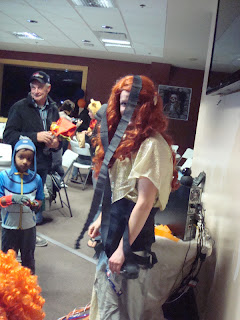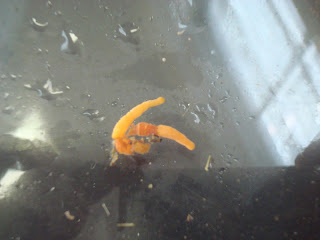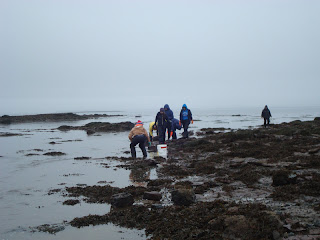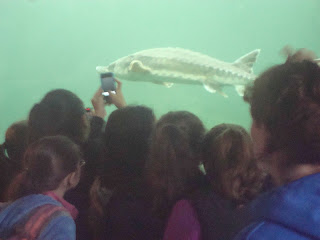Happy Halloween from the Huntsman Marine Science Centre. We hope that everyone stays safe tonight and that the weather left over from Hurricane Sandy lets up in order to enjoy some fun Halloween activities.
In the ocean there are many places that are still being explored or have not yet been explored. Scientists are discovering new weird and wonderful things all the time. Here are some new somewhat spooky discoveries that have been made in the depths of the ocean, in only the last decade!
Wednesday, 31 October 2012
Monday, 29 October 2012
Halloween at the Huntsman
On Saturday we welcomed all kinds of ghosts, goblins, princesses and even an garden gnome to the Huntsman for our annual Halloween haunt. A great time was had by all, as the children were led on a journey through the aquarium by our very own mermaid! The children had to solve various mysteries and puzzles in order to find their way to our party room for games and refreshments. It was a great night and I cannot wait until the next one! To keep updated on all the events happening at the Huntsman visit http://www.huntsmanmarine.ca/events.php
Getting ready to wrap some mummies!
Enjoying the refreshments and the games.
Our mermaid, Janie, getting in on the mummy wrapping fun!
A well wrapped mummy.
Our Phantom of the Aquarium, Genny.
More games!
The Phantom likes to play too!
Thursday, 18 October 2012
ECS Day 3
Today is the last day that the students from ECS in Montreal will be here at the Huntsman. The students began the day with a field trip to Pottery Creek where they took note of and marked the invasive species; green crabs. This is done a few times a year in order to keep track of the population of this species and also to monitor its movements. This data is important, as it gives us an idea of how far and how quickly this particular invasive species has spread. Before lunch the students created artwork of different sea life for our Colour Spectrum Mural which is on display in the lower level of the aquarium. This afternoon the students will be studying the feeding rate of barnacles and how it is affected by temperature change.

In order to find the green crabs, the students and their teachers, looked under rocks and seaweed.
Some of the data collected from Pottery Creek. Note that there are many more male crabs than female.
As the tide came in some areas of the beach became inaccesable.
Here students bearing crabs converge on Tracey so that she may mark and record the data.
Looking under the rocks is sometimes a team effort.

This particular crab, marked with a smiley face, might not be happy to see you if you can catch him again.
Wednesday, 17 October 2012
ECS Day Two
Today the students from E.C.S. started the morning on the beach near the Bar Road looking for worm specimens. The students spent the time digging for the worms by first identifying the areas of the beach most likely inhabited by the worms. After the students finished collecting their samples, it was back to the lab to create a dichotomous key to help with the classification of each species. While in the lab the students looked at blood worms, clam worms, trumpet worms and a few others.
This afternoon the students will be going aboard the Quoddy Link in hopes of catching a glimpse of some fascinating marine mammals; whales and seals.
This afternoon the students will be going aboard the Quoddy Link in hopes of catching a glimpse of some fascinating marine mammals; whales and seals.
The students head out on to the beach on a sunny but chilly morning.
The students lost no time in getting down to business; digging worms!
It is very important to break apart the dirt so you do not miss any possible specimens.
The students worked in groups of 2 or 3 to look for the worms.
Here is a nice example of one of the specimens found.
Checking the shovel and the ground below will ensure that all worms are accounted for.
A Clam Worm.
The students are back in the lab to classify the different worms they collected.
The Acorn Worm.
More Clam worms.
Watch how these Blood Worms move!
Tuesday, 16 October 2012
ECS
Today we are joined by a group of 14 students and 2 staff from E.C.S., a girl's school in Montreal. The students arrived yesterday evening with the intention of getting an early start today with a trip to Indian Point to look at the intertidal environment. After this exploration it was back to the Huntsman for a tour of the Discovery centre and a closer look at the seals during feeding time. While at the aquarium the students also watched a short film about the tides in the Bay of Fundy and why they are some of the highest in the world.
After lunch the students will be going out on the boat, the Fundy Spray to drag for plankton as well as the many different species of invertebrates that call the bottom of the bay their home. Then its back to the lab for a closer look at the specimens brought back.
After lunch the students will be going out on the boat, the Fundy Spray to drag for plankton as well as the many different species of invertebrates that call the bottom of the bay their home. Then its back to the lab for a closer look at the specimens brought back.
A trip to Indian Point to study the intertidal zone.
Searching under rocks and seaweed, you are sure to spot a crab or two.
Crab in a bucket.
What did you find?
These girls waded in the water as the tide started to come in.
Even the teachers were busy looking for and studying the intertidal specimens.
A small green crab that shows an interesting colouring; note the red spot on its back.
The rising tide was quickly cutting off parts of the beach from us.
Here the students are taking a break among the seaweed.
Listening intently about the lobster during the tour of the aquarium.
Check out the ancient sturgeon!
Around the touch pool. The moon snails were a big hit.
Saturday, 13 October 2012
Saint John High Seniors Overnight
Yesterday we were joined by a group of Grade 12 students from Saint John High School. These students came to the Huntsman for a two day trip in which to further their learning about the aquatic environment and the plants and animals that call the ocean their home. Soon after they arrived yesterday they were given a review on the plants and animals they may encounter while at the shore. Then they learnt all about the American Lobster with guest speaker Genny Simard; our Aquarium Interpreter. After that the students went to Holey Point where they marked periwinkles in order to estimate the population there and then completed a zonation activity to record geological and biological data from the beach. That evening they used their data collected at the beach to create graphs.
This morning the students returned to Holey Point to recapture their periwinkles and complete their formula's for the estimation of the population. They then returned to the lab to learn more about how to set up behavioural experiments before designing their own experiment to be completed in the afternoon. Many different experiments were carried out by the students; some looked at how temperature or salinity affected behaviour and others looked at environment.
This morning the students returned to Holey Point to recapture their periwinkles and complete their formula's for the estimation of the population. They then returned to the lab to learn more about how to set up behavioural experiments before designing their own experiment to be completed in the afternoon. Many different experiments were carried out by the students; some looked at how temperature or salinity affected behaviour and others looked at environment.
One of the zonation graphs made by the students.
Keeping a good record of data is very important when completing experiments
This experiment involved temperature and the behaviour of sea urchins.
One of the many test subjects used.
Weight of the test subjects was also recorded for interpretation.
Thursday, 11 October 2012
Saint John High School Group 3
Today the third group of Grade 10 students arrived at the Huntsman to participate in similar activities as the two groups before them. Each student had to chance to go on the boat to drag for plankton and discover other marine life as well as study plankton under the microscope. In the afternoon the students classified the collected marine specimens by phylum and also looked at the feeding rate of barnacles when placed in different temperatures.
The students waited patiently for the scallop drag to be completed.
This is the basket that is used to collect specimens from the floor of the bay.
A student carefully handles a Brittle Star while identifying it's phylum.
Some of the specimens the students used for classification. These belong to the phylum Porifera and Mollusca.
Subscribe to:
Comments (Atom)

















































